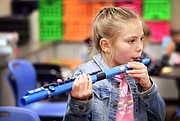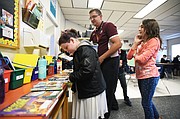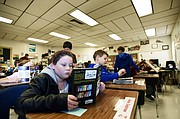When classroom budgets are tight, teachers turn to crowdfunding
Teachers are tapping into the power of the people when searching for funding beyond the classroom budget.
From basic supplies and snacks to big-ticket items and technology, educators are going online and reaching across state lines for financial support through nonprofit crowdsourcing sites geared specifically to raising money for schools such as DonorsChoose.org and AdopAClassroom.org.
DonorsChoose is open to public schools and AdopAClassroom.org is open to both public and private schools. They allow educators to designate if a school has a high population of low-income students.
Between the two sites, donors may find local schools with current fundraising proposals in Evergreen, Cayuse Prairie, Columbia Falls, Helena Flats, Kalispell, Ronan and Smith Valley.
Francy Moll is a first-grade teacher at K. William Harvey Elementary School in Ronan who uses online crowdfunding as a go-to in supplementing her classroom budget of about $150.
Since 2016, she’s had 37 projects fully funded by 345 donors on DonorsChoose.org and about seven that weren’t. If a proposal isn’t fully funded in a specific time frame on this site, donations are credited back to donors, who may opt to apply it as a gift card to the teacher or to another project.
Moll does a lot of online crowdfunding for snacks and basic supplies such as pencils, folders, dry-erase markers, crayons and cleaning products such as disinfectant wipes, which come in handy during flu season, she said.
When it comes to these items, she said her goal is take some of the financial burden off families in purchasing back-to-school supplies.
“It’s definitely worth it for me because you don’t have to ask parents for things throughout the year. Some parents always give to classroom and some that want to give are just not able to. I try to make it so no one feels bad,” Moll said.
Crowdfunding has also meant Moll has spent less out-of-pocket.
“I was spending about a $1,000 a year out of pocket,” Moll said and wouldn’t always request reimbursement. “Now it’s very minimal, under $40.”
Montana teachers spend on average $373 of their own money per school year, according to the Economic Policy Institute.
“Most teachers do it because they love kids,” Moll said about out-of-pocket spending or crowdfunding efforts.
Some of the items she seeks crowdfunding for support students outside the classroom walls and include gloves, hats, pajamas and books for students to take home.
“Most of us feel on the reservation we have to meet the basic needs before we can teach them,” Moll said. “That’s why we do take care of the whole child, so they are ready to learn.”
In the past, she has also purchased big-ticket items that are popular on crowdfunding sites, such as Chromebooks, tablets, robots and special seating.
Moll said it’s worth the effort of writing up a proposal, getting administrator approval, posting updates and getting thank-yous out to donors.
“I feel as an educator — I’ve cried more than once when things get funded,” Moll said. “When somebody I don’t know funds pajamas and socks — it’s huge.”
Cayuse Prairie music teacher Jennifer Murrell is in her second year at school and in the midst of her second crowdfunded project.
Unsurprisingly, her proposals focus on raising money for instruments, which are expensive.
“We’re at a point where instruments need to be replaced,” Murrell said.
Her classroom budget of about $500 is primarily used for immediate needs that come up throughout the year, such as instrument repairs or items that benefit the most students or get a lot of use such as recorders and rhythm instruments.
The sky isn’t the limit, however, even online. According to DonorsChoose.org, projects under $200 have a 90% chance of being funded, while projects more than $1,000 are funded about 43% of the time.
Taking this into consideration, Murrell looked at the top priority — trumpets.
“We have three students who want to play trumpet, but we only have two trumpets available and one had to go in for repairs,” Murrell said, so she turned to crowdfunding.
Looking at costs, Murrell decided she would have a better chance of funding three plastic trumpets at $680 versus their brass counterparts.
“I knew we needed three, so they were cheaper than the metal ones and I thought we’d have better luck getting three of them,” she said.
She also found success in her previous proposal of purchasing two plastic flutes. She said they are great beginner instruments for third- and fourth-graders who can play without fear of damaging a more expensive metal instrument
“They are designed for smaller kids. They don’t get broken easily,” Murrell said.
Murrell said the experience of online crowdfunding has been positive in that it reaches people who are specifically seeking to donate to specific causes versus convincing people of the need through traditional avenues such as grant writing or fundraising.
“There are people who go in and just search for projects — science projects, math projects, — you’re getting people looking for those things,” Murrell said.
This doesn’t mean teachers stop seeking grants or schools stop fundraising. Crowdfunding is just another tool for teachers and schools comfortable with using it.
Josh Preiss, a fourth-grade teacher at Ruder Elementary in Columbia Falls, said he’s found success in getting both grants and using crowdfunding to supplement a classroom budget of nearly $300. When it comes to out-of-pocket spending, he said it’s ranged from $200 to $600.
Some of the items Preiss has spent his own money on include books on audio, classroom storage, prizes to incentivize children and art supplies.
Online, Preiss has had three funded proposals and is hoping to have a fourth currently underway. He is currently requesting $555 to continue updating his classroom library.
“I came into the classroom with a lot of old books. I brought my books from home, but I had a pretty weak library,” Preiss said.
While the adage goes “don’t judge a book by its cover,” young students do, and Preiss said there is nothing quite like students’ excitement in picking a new book, or a classic with an updated cover.
“I’ve added full series like ‘Harry Potter,’ ‘Diary of a Wimpy Kid,’ and classics like the ‘Wizard of Oz,’” he said.
“Our reading motivation went off like a rocket,” Preiss said as he began to update the library.
Ronan High School science teacher Jedd Tougas is a first-year teacher looking to establish his classroom while remaining cognizant of the budget, which he said is roughly $1,800 shared between the high school’s three science teachers.
His first successful proposal funded the purchase of chemistry kits — pre-built labs containing lessons and materials. The second, and most recent, was for $1,132 for three Chromebooks dedicated to students working on chemistry, physics and earth science labs. He is seeking to post another proposal in the winter to purchase sensors that students can use outside the classroom to do field work.
“It was easier than I thought it would be,” Tougas said. “It was pretty straightforward. You set what the project goals are, what kids will get out of it and how you’ll be able to support them.”
On DonorsChoose.org the cost of materials requested are broken down for people to look at where the money will be spent, including shipping charges and fees associated with processing and labor. There is also an optional 15% suggested donation for overhead costs to operate the nonprofit.
While the sites outline requirements and guidelines for participating, schools also have to figure out how online crowdfunding fits into their own policies and procedures.
To assist districts in managing the rise of online crowdfunding in schools, Montana School Boards Association created a model policy in 2016 specific to crowdfunding proposals that is optional for districts to adopt, according to Kris Goss, director of policy services for Montana School Boards Association.
Goss said the optional policy sets a framework for staff. The policy, which districts may tailor to their needs, works to ensure a proposal gets administrator approval and is compatible with existing district plans, initiatives and infrastructure, but doesn’t add to the demands of staff not involved in the proposal.
Some districts adopted the optional policy years ago, while some districts, including Kalispell Public Schools, adopted it recently. Other districts such as Columbia Falls and Cayuse Prairie that don’t have crowdfunding policies, do have ones in place that address general fundraising, gifts, endowments and investments.
Reporter Hilary Matheson may be reached at 758-4431 or hmatheson@dailyinterlake.com.








